From the Editor – March 2024
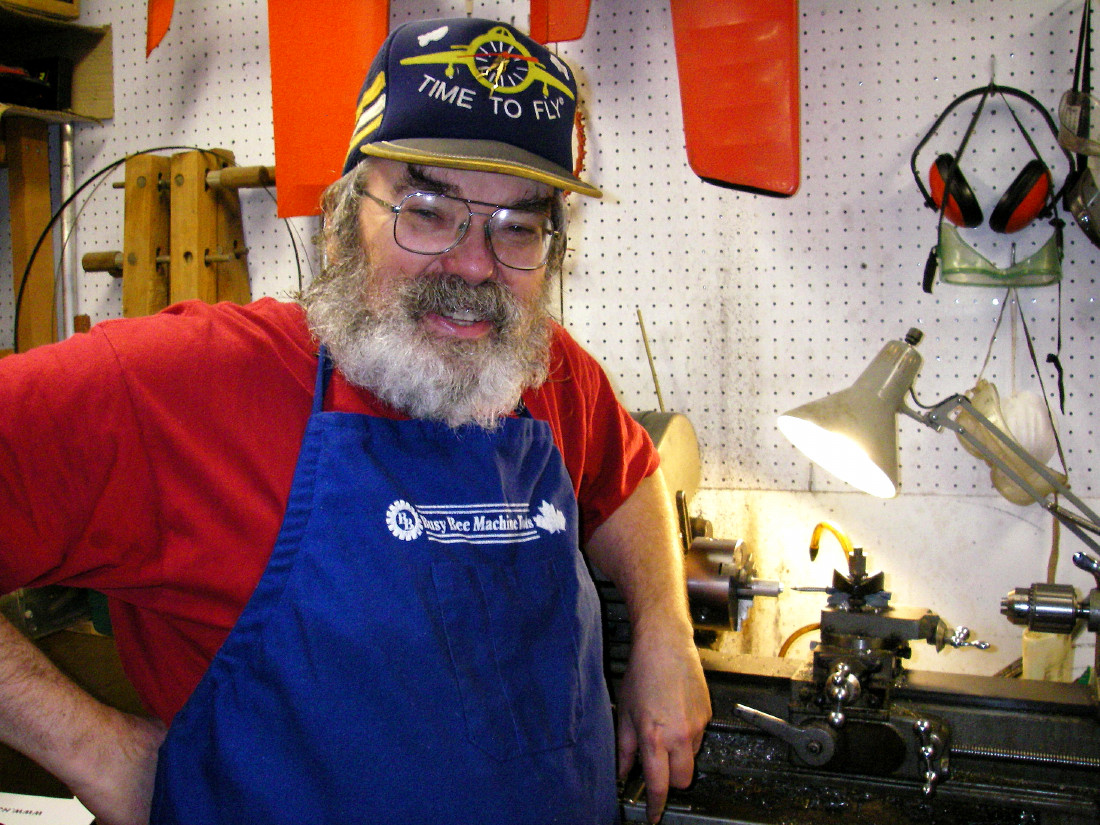 Greetings to one and all! I’m happy to be able to report that I’m still on deck and am well embarked upon the next stage of treatment for the tumor that ails me. The doctor from the BC Cancer Agency has put me on tumor-reduction medication, which I’ve been taking now for a month. This won't do its work overnight, and I will be monitored on a regular basis to see how well the tumor is responding to the medication. So far, the indications are good – the tumor has already shrunk to a significant extent.
Greetings to one and all! I’m happy to be able to report that I’m still on deck and am well embarked upon the next stage of treatment for the tumor that ails me. The doctor from the BC Cancer Agency has put me on tumor-reduction medication, which I’ve been taking now for a month. This won't do its work overnight, and I will be monitored on a regular basis to see how well the tumor is responding to the medication. So far, the indications are good – the tumor has already shrunk to a significant extent.
As long as the tumor keeps shrinking, they'll hold off on surgery. When the tumor seems to have shrunk as much as it's going to, they'll have a go at taking it out. Even though things are progressing positively at the moment, it still seems highly unlikely that surgery will take place prior to the coming summer, and that's assuming that the medication continues to be effective.
The major worry up to this point has been the possibility of side effects from the medication. I'm told that the majority of people don't experience severe side effects with this medication (Imatinib), and hopefully I'll be one of them - so far, such effects have thankfully been minimal.
Meanwhile, I remain on blood thinners to help deal with the blood clot issue. For the moment, engine testing remains out - I can't afford to get any significant cuts as matters stand. I also have to minimize my contact with others, since one effect of the tumor-reduction medication is to compromise my immune system to some degree. Given the current prevalence of Covid, RSV and Strep A among the population at large, most of whom are taking no precautions, this represents no small challenge.
 Enough about me!! I’ll begin this month’s Editorial by noting that a good few of us were very concerned to find that the late Ron Chernich’s invaluable “Model Engine News” (MEN) website went “down” on February 19th, 2024. People attempting to access the site got an “Account Temporarily on Hold” notification. Maris Dislers quickly confirmed that the domain registration was paid up and current, leading to a suspicion that something had gone pear-shaped with the hosting – perhaps an unpaid charge for which no invoice had been received. Maris commenced an immediate investigation, finding that the hosting charges were in arrears. It’s now sorted, and the site went back up as of February 22nd. Our sincere thanks are due to Maris for his timely intervention!
Enough about me!! I’ll begin this month’s Editorial by noting that a good few of us were very concerned to find that the late Ron Chernich’s invaluable “Model Engine News” (MEN) website went “down” on February 19th, 2024. People attempting to access the site got an “Account Temporarily on Hold” notification. Maris Dislers quickly confirmed that the domain registration was paid up and current, leading to a suspicion that something had gone pear-shaped with the hosting – perhaps an unpaid charge for which no invoice had been received. Maris commenced an immediate investigation, finding that the hosting charges were in arrears. It’s now sorted, and the site went back up as of February 22nd. Our sincere thanks are due to Maris for his timely intervention!
This experience is a salutary reminder of the vulnerability of on-line resources like Ron’s site. Any such resource (like my own site) will always be subject to the vagaries of the cyber-world which we now inhabit. No website can be guaranteed against such failures, and nothing is forever in cyber-space, especially sites like Ron’s for which no maintenance is possible. For this reason, I recommend that readers consider downloading any of my articles of particular relevance so that even if the site goes away for reasons beyond my control (as it undoubtedly could), the information will be preserved.
Apart from that scare, there's some model engine news to report this month - first time for a while! To start with, I heard from two of my most valued readers, Otto Mederle of Germany and Olli-Matti Karhunen of Finland. These gentlemen are among the world’s most talented currently-active home builders of model engines. They both wrote in to tell me about their latest accomplishments.
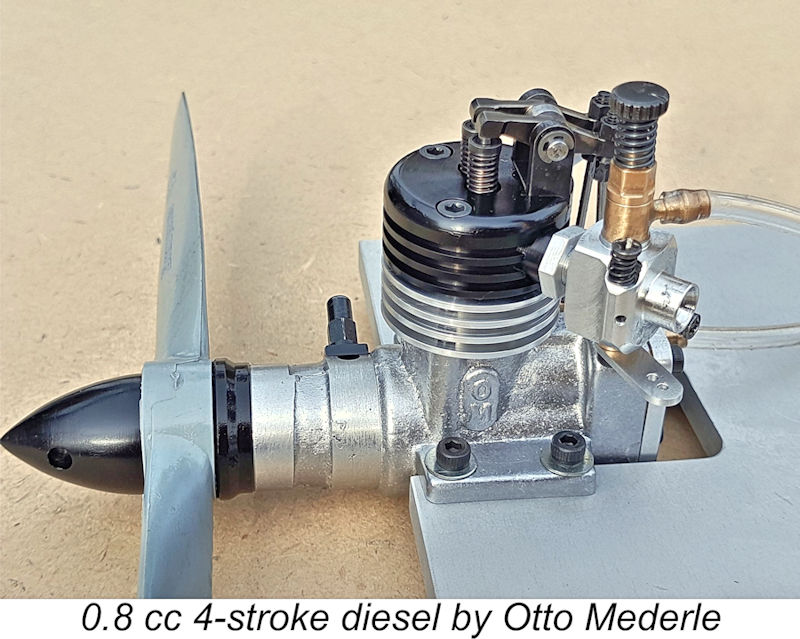 In an earlier Editorial, I’ve mentioned Otto’s efforts to develop very small 4-stroke diesel engines. His first effort, a 1 cc model, worked out very well, as previously reported. He then proceeded to construct two models of only 0.8 cc displacement – one with a V-valve head and one with parallel valves. The V-valve model proved to be very hard to start, besides being far more difficult to construct – Otto reckons that it’s a dead end. However, the parallel-valve model starts and runs very well indeed. Some idea of its size can be gained from the knowledge that the prop in the picture is a Graupner 7x4, which the engine turns at 9,400 RPM! My congratulations to Otto for a superbly-executed project!
In an earlier Editorial, I’ve mentioned Otto’s efforts to develop very small 4-stroke diesel engines. His first effort, a 1 cc model, worked out very well, as previously reported. He then proceeded to construct two models of only 0.8 cc displacement – one with a V-valve head and one with parallel valves. The V-valve model proved to be very hard to start, besides being far more difficult to construct – Otto reckons that it’s a dead end. However, the parallel-valve model starts and runs very well indeed. Some idea of its size can be gained from the knowledge that the prop in the picture is a Graupner 7x4, which the engine turns at 9,400 RPM! My congratulations to Otto for a superbly-executed project!
Olli-Matti sent in a few details of a replica Rolssi 6.28 cc sparkie which he has just completed to his usual extremely high 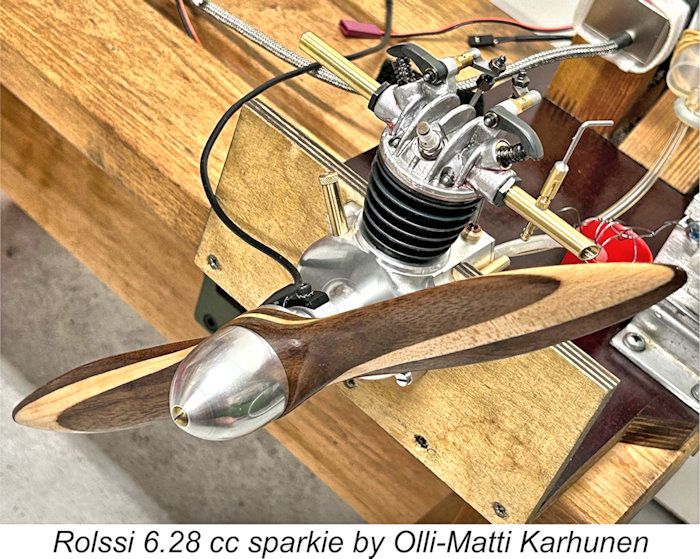 standards. Olli-Matti’s superb re-creation was built from a CAD model developed by a friend of his, who also built an example. It runs very well, developing around 0.25 BHP. It runs on straight gas, using splash lubrication. Check this link for a summary of this outstanding project. I’m in awe of Olli-Matti’s talents – he also made the beautiful “period” 12¾ x5 laminated wood airscrew, which it turns at 6,300 RPM.
standards. Olli-Matti’s superb re-creation was built from a CAD model developed by a friend of his, who also built an example. It runs very well, developing around 0.25 BHP. It runs on straight gas, using splash lubrication. Check this link for a summary of this outstanding project. I’m in awe of Olli-Matti’s talents – he also made the beautiful “period” 12¾ x5 laminated wood airscrew, which it turns at 6,300 RPM.
The original Rolssi 6.28 was designed in Finland way back in 1935-36 and was constructed by a talented and enthusiastic group of aircraft mechanics in the Vyborg region. It powered a free-flight model called “Bebe”, establishing some significant flight duration records at the time. Sadly, the original engine was lost in the conflict of WW2 when the Russians invaded the Vyborg area, forcing Finland to fight for its independence (sound familiar?!?). Having built the engine, Olli-Matti plans to build a replica of the original "Bebe" model for it. A truly historic re-creation!
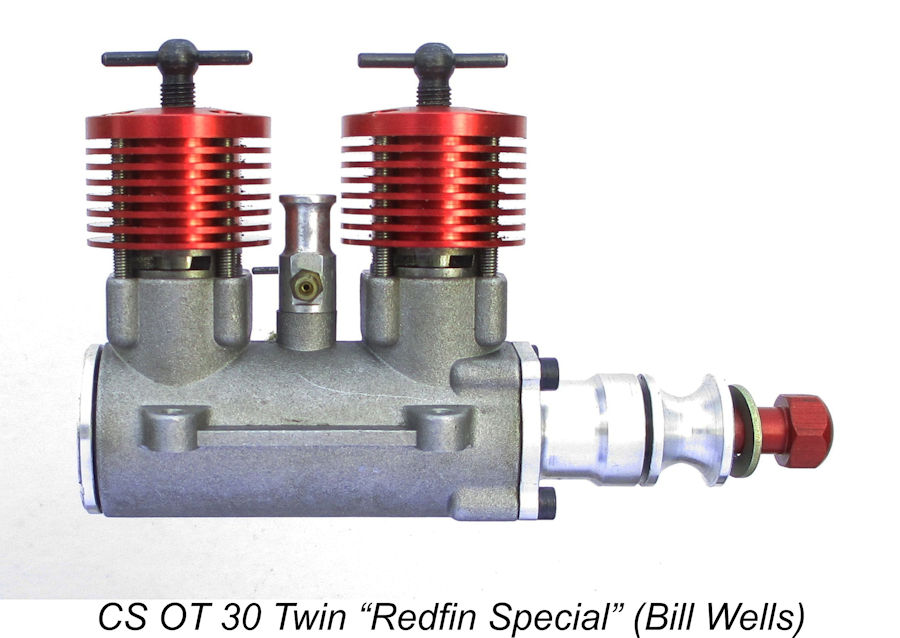 My English mate Bill Wells provided some information regarding a variant of the CS OT 30 Twin of which I wasn’t aware. This was a red-anodized and serial-numbered special edition of the engine sold in small numbers by Alex Phin of Redfin Engines in England. I’ve added a few paragraphs on this variant to the end of the previously-published article on this engine.
My English mate Bill Wells provided some information regarding a variant of the CS OT 30 Twin of which I wasn’t aware. This was a red-anodized and serial-numbered special edition of the engine sold in small numbers by Alex Phin of Redfin Engines in England. I’ve added a few paragraphs on this variant to the end of the previously-published article on this engine.
As is so often the case, my good mate Maris Dislers has come through yet again with an update of his earlier article on the OK Cub reed valve models. Maris has undertaken some 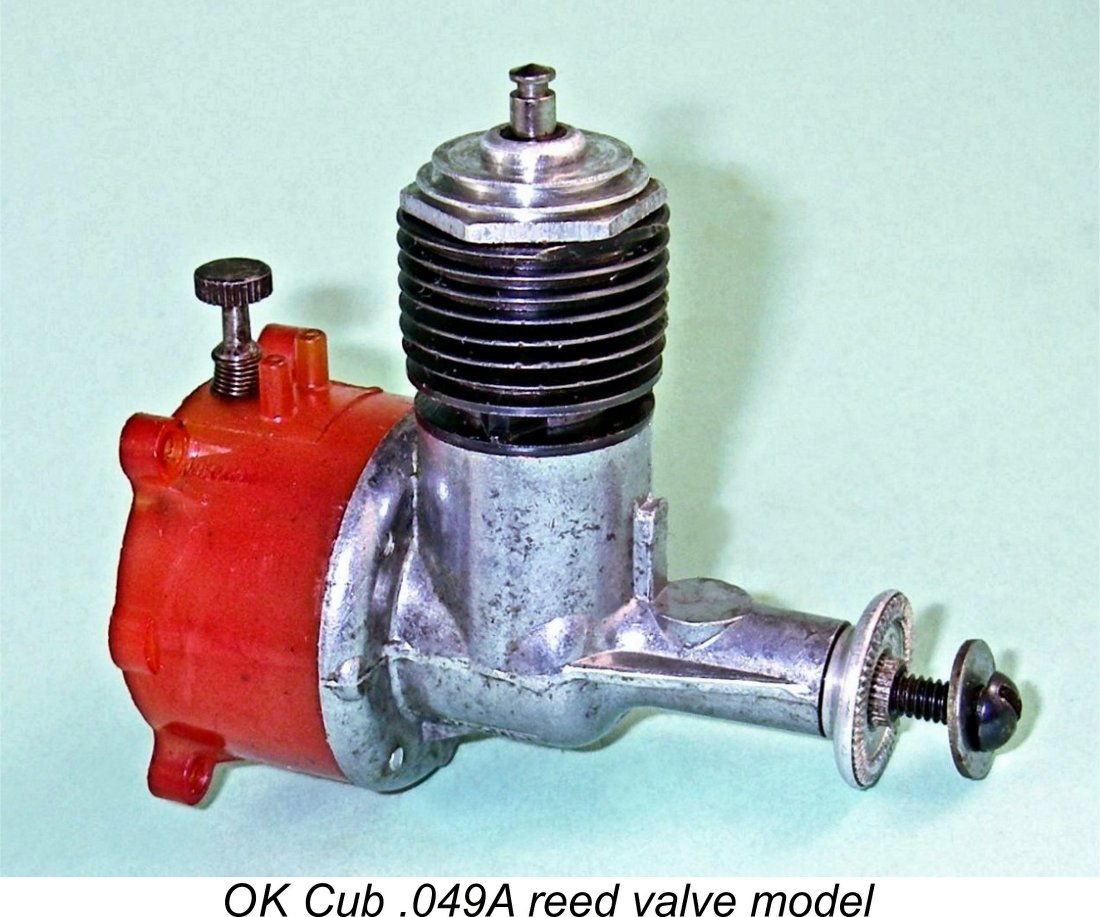 further testing which has confirmed that the reed valve Cubs must have been a bit of a disappointment to their designer Charles Brebeck Sr. Anyone having an interest in these engines should definitely check out the revised text.
further testing which has confirmed that the reed valve Cubs must have been a bit of a disappointment to their designer Charles Brebeck Sr. Anyone having an interest in these engines should definitely check out the revised text.
Now it’s confession time! I will admit to having fallen prey to one of those “impulse buying” fits which plague us all from time to time. While idly surfing on eBay, I came across a particularly interesting-looking little Stirling Cycle hot air engine from China. I’ve always rather liked Stirling Cycle engines, and I have a few examples lying about. What attracted me to this one was its superficial resemblance to an opposed-twin I/C engine, complete with airscrew!
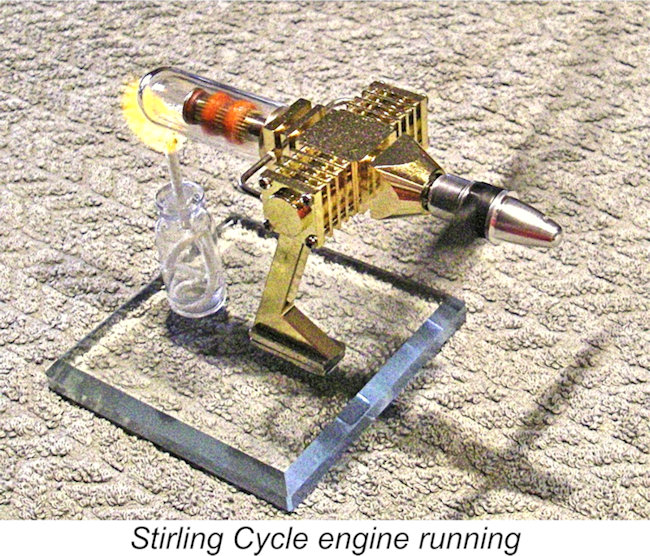 I’ll openly confess that I took the bait and ordered one. It arrived very promptly in perfect order, having been well packed and shipped fast. Some basic assembly was required, which was made a little more challenging by the absence of any assembly instructions! However, it was easy to figure out, and it went together just fine.
I’ll openly confess that I took the bait and ordered one. It arrived very promptly in perfect order, having been well packed and shipped fast. Some basic assembly was required, which was made a little more challenging by the absence of any assembly instructions! However, it was easy to figure out, and it went together just fine.
I haven’t disturbed the main power unit, since I suspect that the assembly is a little “delicate”. However, I have tried it out, with completely satisfactory results. The heat source is a small spirit burner which heats the clear (presumably) Pyrex “hot chamber” which protrudes at the rear. The engine runs very well indeed, turning the 5 in. dia. nylon airscrew with which it is supplied at over 3,500 RPM while the visible displacer moves rapidly back and forth. Definitely not a “real” model aero engine (to say nothing of the fire hazard in a model!), but a great desk-top plaything for an engine guy like me!
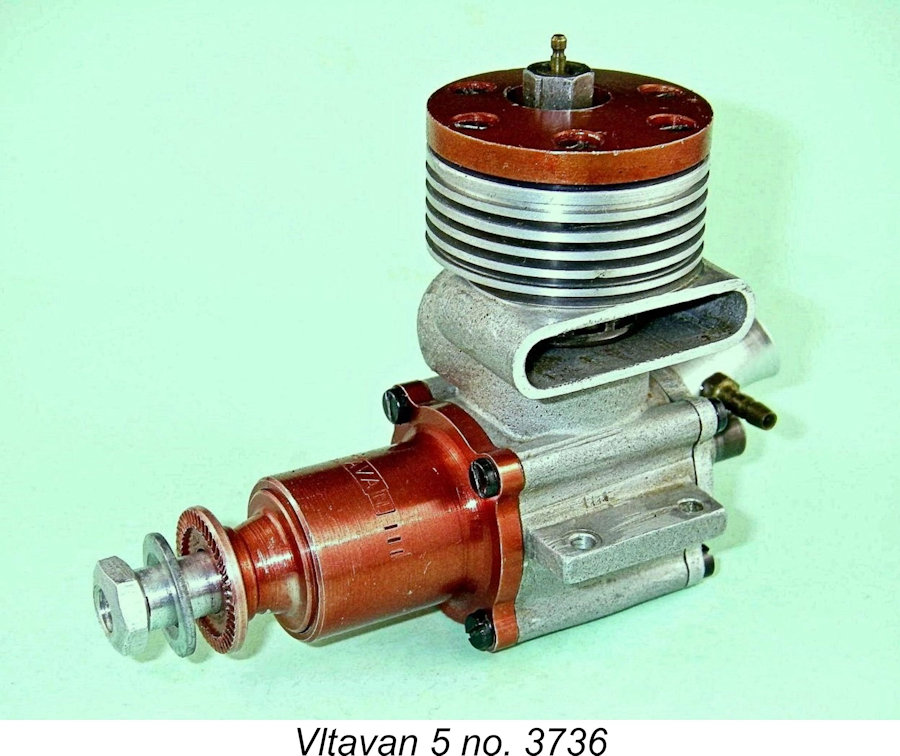 Once again, I’ve managed to get some new material up on the site for your reading pleasure. Like last month’s efforts, two of the articles are related MEN transfer topics upon which I’ve been working off and on for some time. The first is a review of the somewhat underrated Vltavan 5 racing engine from Czechoslovkia (as Czechia was back then.). This complements my earlier review of the equally underrated companion Vltavan 2.5 from the same source. The Vltavan 5 is actually a really good engine which has never received the credit to which its many positive attributes entitle it. I hope that my article sets the record straight!
Once again, I’ve managed to get some new material up on the site for your reading pleasure. Like last month’s efforts, two of the articles are related MEN transfer topics upon which I’ve been working off and on for some time. The first is a review of the somewhat underrated Vltavan 5 racing engine from Czechoslovkia (as Czechia was back then.). This complements my earlier review of the equally underrated companion Vltavan 2.5 from the same source. The Vltavan 5 is actually a really good engine which has never received the credit to which its many positive attributes entitle it. I hope that my article sets the record straight!
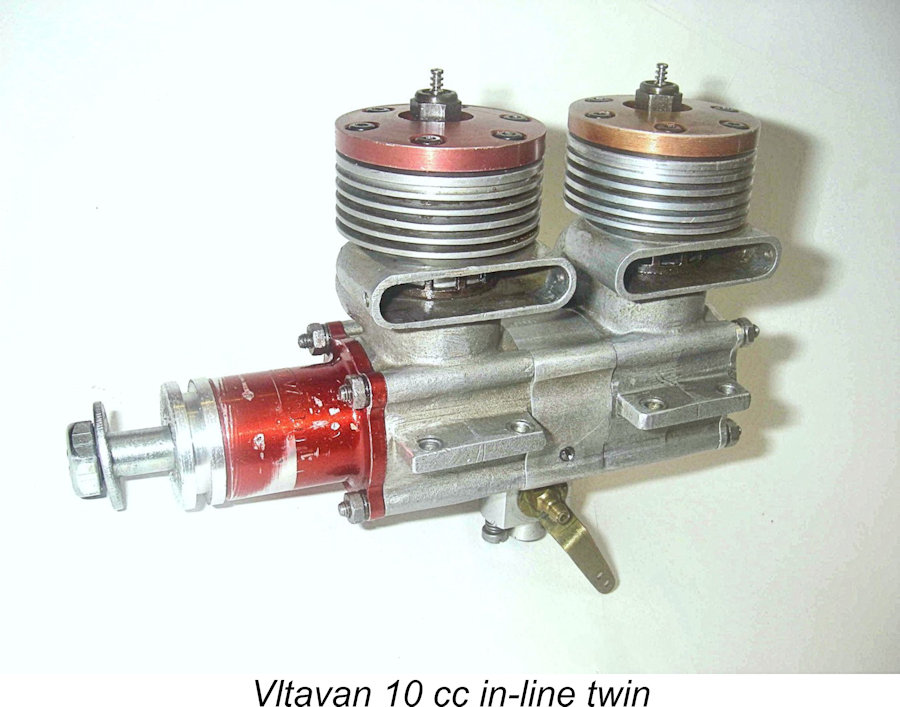 While I was at it, I thought that I should complete this website's coverage of the Vltavan engines by adding my article on the very rare Vltavan 10 cc twins which were made during the 1960’s by a number of individuals. This unit was a very well-considered exercise in twinning two standard Vltavan 5 units to make an in-line 10 cc alternate-firing glow-plug twin. My example of this creation is very well executed, and there’s much to be learned from a review of its design and construction - the same approach could be used to twin a variety of different units. Enjoy!
While I was at it, I thought that I should complete this website's coverage of the Vltavan engines by adding my article on the very rare Vltavan 10 cc twins which were made during the 1960’s by a number of individuals. This unit was a very well-considered exercise in twinning two standard Vltavan 5 units to make an in-line 10 cc alternate-firing glow-plug twin. My example of this creation is very well executed, and there’s much to be learned from a review of its design and construction - the same approach could be used to twin a variety of different units. Enjoy!
However, MEN transfer articles don’t really add any new information – they simply maintain or improve the accessibility 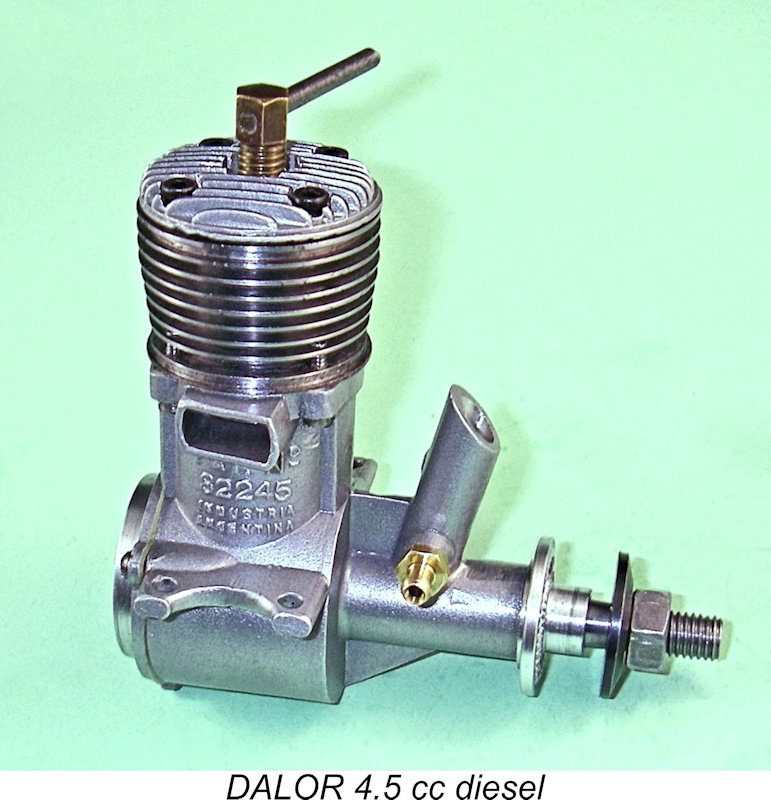 of what’s already out there! It’s the all-new articles which add to our shared knowledge, and I have a good one for you this month – a review and test of the mega-rare DALOR 4.5 cc diesel from Argentina. Thankfully I had completed the testing of this engine prior to being laid up with the tumor and being put on blood thinners.
of what’s already out there! It’s the all-new articles which add to our shared knowledge, and I have a good one for you this month – a review and test of the mega-rare DALOR 4.5 cc diesel from Argentina. Thankfully I had completed the testing of this engine prior to being laid up with the tumor and being put on blood thinners.
Preparing this article has presented me with an opportunity to summarize the hitherto poorly-documented history of model engine manufacture in Argentina as far as I’ve been able to ferret it out. It’s an interesting story that definitely covers some seldom-trodden ground and richly deserves to be shared. I’m certain that I don’t have anything like the full story even now, so if any kind reader can add to the tale, please get in touch!! I can’t do this alone ………
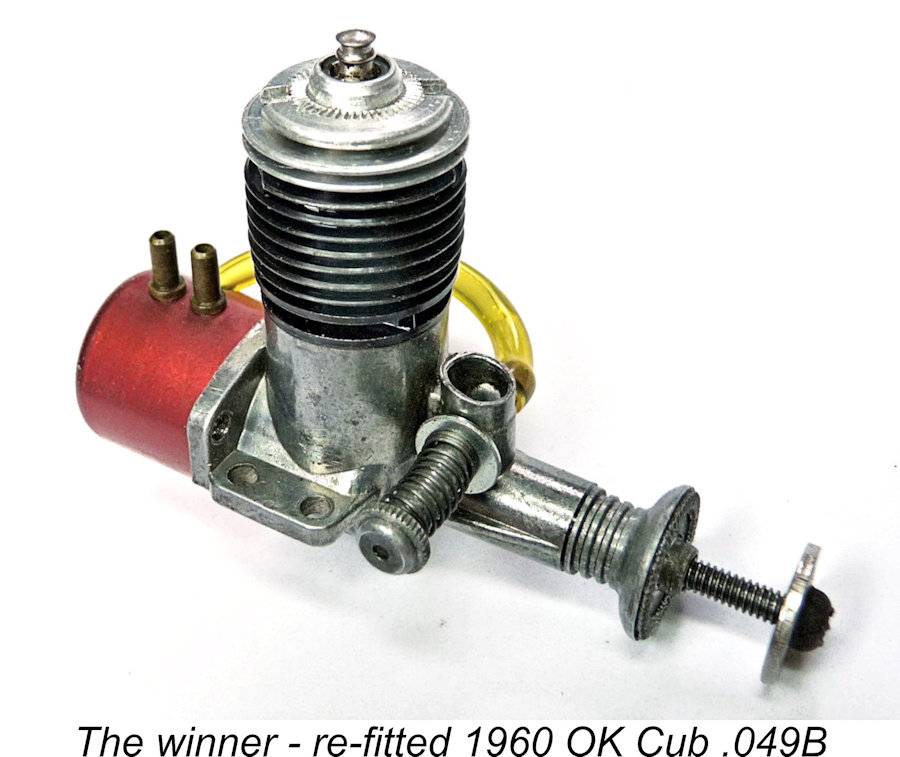 As if this wasn’t enough, I received yet another all-new contribution from Maris Dislers. Staying with the OK Cub series, Maris reminded me that his previous article on the early OK Cub designs only took the story up to the end of 1949. Maris has now prepared a new article covering the second-generation OK Cubs, going all the way up to the final models in that long-running series. Of particular interest are some experiments that he carried out with the final 1960 version of the Cub .049B, demonstrating that this had the potential to be a truly excellent ½A glow-plug motor with a sparkling performance. Only a cylinder design error stood in the way of the engine achieving that status for all to see.
As if this wasn’t enough, I received yet another all-new contribution from Maris Dislers. Staying with the OK Cub series, Maris reminded me that his previous article on the early OK Cub designs only took the story up to the end of 1949. Maris has now prepared a new article covering the second-generation OK Cubs, going all the way up to the final models in that long-running series. Of particular interest are some experiments that he carried out with the final 1960 version of the Cub .049B, demonstrating that this had the potential to be a truly excellent ½A glow-plug motor with a sparkling performance. Only a cylinder design error stood in the way of the engine achieving that status for all to see.
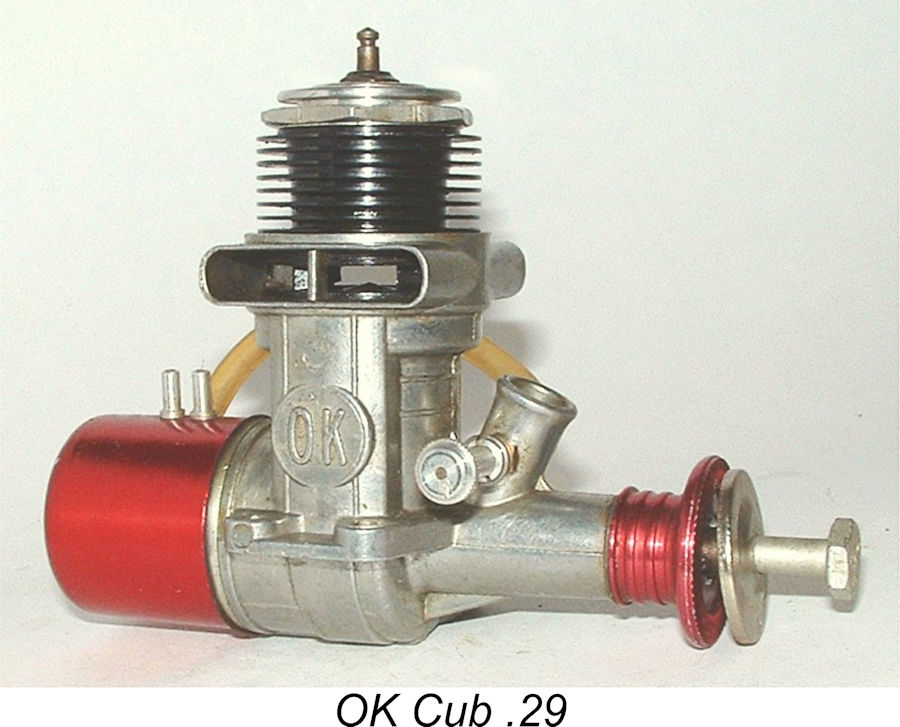 Maris’s latest article pretty much completes the coverage of the OK Cub engines on this website, with the exception of the largest-ever OK Cubs – the .29 and .35 cuin. models. Having nice examples of both models on hand, I’m in a good position to remedy this omission. I plan to do so in a future article once I get past the critical stages of dealing with my present health challenges. They're suprisingly good runners which deserve to be better appreciated.
Maris’s latest article pretty much completes the coverage of the OK Cub engines on this website, with the exception of the largest-ever OK Cubs – the .29 and .35 cuin. models. Having nice examples of both models on hand, I’m in a good position to remedy this omission. I plan to do so in a future article once I get past the critical stages of dealing with my present health challenges. They're suprisingly good runners which deserve to be better appreciated.
That’s about it for this month! I can’t make any firm promises to get anything out for April, but I will promise to give it a try. Given my medical situation, it seems quite likely that the site will become frozen at some point, at least for a while, but I’ll keep going as long as I can – doing so helps to divert attention away from less positive issues! I’ll keep you all posted on any significant developments. In the meantime, I really appreciate all the expressions of support that I’ve received from so many of you!
Take care, and I’ll see you on the other side of this dratted health issue!
Adrian Duncan
British Columbia, Canada
_____________________________
Note regarding material to be found on this site - unless specifically otherwise noted, all images and text which appear on this site are my own work, and I hereby assert my right to be recognized as the originator of this material. For the record, this material is made freely available to all upon two firm conditions:
- No commercial use of any kind is to be made of any of the images or text posted on this site without my express written consent.
- No use of any kind, commercial or otherwise, is to be made of any material published in any form on this site without full and open acknowledgement of the source.

 Greetings to one and all! I’m happy to be able to report that I’m still on deck and am well embarked upon the next stage of treatment for the tumor that ails me. The doctor from the BC Cancer Agency has put me on tumor-reduction medication, which I’ve been taking now for a month. This won't do its work overnight, and I will be monitored on a regular basis to see how well the tumor is responding to the medication. So far, the indications are good – the tumor has already shrunk to a significant extent.
Greetings to one and all! I’m happy to be able to report that I’m still on deck and am well embarked upon the next stage of treatment for the tumor that ails me. The doctor from the BC Cancer Agency has put me on tumor-reduction medication, which I’ve been taking now for a month. This won't do its work overnight, and I will be monitored on a regular basis to see how well the tumor is responding to the medication. So far, the indications are good – the tumor has already shrunk to a significant extent. Enough about me!! I’ll begin this month’s Editorial by noting that a good few of us were very concerned to find that the late Ron Chernich’s invaluable “
Enough about me!! I’ll begin this month’s Editorial by noting that a good few of us were very concerned to find that the late Ron Chernich’s invaluable “ In an
In an 
 My English mate Bill Wells provided some information regarding a variant of the
My English mate Bill Wells provided some information regarding a variant of the  further testing which has confirmed that the reed valve Cubs must have been a bit of a disappointment to their designer Charles Brebeck Sr. Anyone having an interest in these engines should definitely check out the revised text.
further testing which has confirmed that the reed valve Cubs must have been a bit of a disappointment to their designer Charles Brebeck Sr. Anyone having an interest in these engines should definitely check out the revised text. I’ll openly confess that I took the bait and ordered one. It arrived very promptly in perfect order, having been well packed and shipped fast. Some basic assembly was required, which was made a little more challenging by the absence of any assembly instructions! However, it was easy to figure out, and it went together just fine.
I’ll openly confess that I took the bait and ordered one. It arrived very promptly in perfect order, having been well packed and shipped fast. Some basic assembly was required, which was made a little more challenging by the absence of any assembly instructions! However, it was easy to figure out, and it went together just fine. Once again, I’ve managed to get some new material up on the site for your reading pleasure. Like last month’s efforts, two of the articles are related MEN transfer topics upon which I’ve been working off and on for some time. The first is a review of the somewhat underrated
Once again, I’ve managed to get some new material up on the site for your reading pleasure. Like last month’s efforts, two of the articles are related MEN transfer topics upon which I’ve been working off and on for some time. The first is a review of the somewhat underrated  While I was at it, I thought that I should complete this website's coverage of the Vltavan engines by adding my article on the very rare
While I was at it, I thought that I should complete this website's coverage of the Vltavan engines by adding my article on the very rare  of what’s already out there! It’s the all-new articles which add to our shared knowledge, and I have a good one for you this month – a review and test of the mega-rare
of what’s already out there! It’s the all-new articles which add to our shared knowledge, and I have a good one for you this month – a review and test of the mega-rare  As if this wasn’t enough, I received yet another all-new contribution from Maris Dislers. Staying with the OK Cub series, Maris reminded me that his previous article on the early OK Cub designs only took the story up to the end of 1949. Maris has now prepared a new article covering the
As if this wasn’t enough, I received yet another all-new contribution from Maris Dislers. Staying with the OK Cub series, Maris reminded me that his previous article on the early OK Cub designs only took the story up to the end of 1949. Maris has now prepared a new article covering the  Maris’s latest article pretty much completes the coverage of the OK Cub engines on this website, with the exception of the largest-ever OK Cubs – the .29 and .35 cuin. models. Having nice examples of both models on hand, I’m in a good position to remedy this omission. I plan to do so in a future article once I get past the critical stages of dealing with my present health challenges. They're suprisingly good runners which deserve to be better appreciated.
Maris’s latest article pretty much completes the coverage of the OK Cub engines on this website, with the exception of the largest-ever OK Cubs – the .29 and .35 cuin. models. Having nice examples of both models on hand, I’m in a good position to remedy this omission. I plan to do so in a future article once I get past the critical stages of dealing with my present health challenges. They're suprisingly good runners which deserve to be better appreciated.